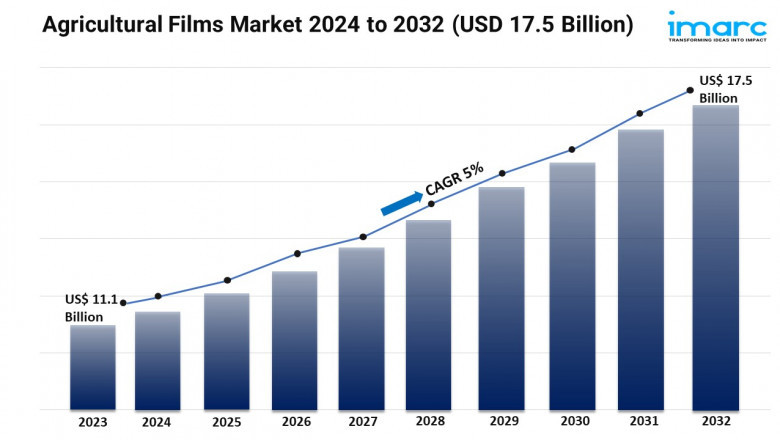views
Global Agricultural Films Market Statistics: USD 17.5 Billion Value by 2032
Summary:
- The global agricultural films market size reached USD 11.1 Billion in 2023.
- The market is expected to reach USD 17.5 Billion by 2032, exhibiting a growth rate (CAGR) of 5% during 2024-2032.
- North America leads the market, accounting for the largest agricultural films market share.
- Linear low-density polyethylene accounts for the majority of the market share in the type segment due to its superior flexibility, tensile strength, and cost-effectiveness.
- Mulching represents the leading application segment.
- The growing global population is a primary driver of the agricultural films market.
- Technological advancements in film manufacturing are reshaping the agricultural films market.
Industry Trends and Drivers:
- Rising Demand for Food Due to Population Growth:
The growing global population is pushing agricultural productivity to new limits, increasing the need for agricultural films. As the demand for food intensifies, farmers are looking for ways to enhance crop yield and quality. Agricultural films help optimize crop growth by improving moisture retention, protecting crops from extreme weather, and reducing weed growth. This, in turn, allows for more efficient farming methods, even in regions with unfavorable climates. The use of mulching films, greenhouse films, and silage films is becoming more common as farmers aim to meet food demands sustainably. These films are also instrumental in reducing the overall use of water and fertilizers, which further drives their adoption.
- Technological Advancements in Film Manufacturing:
The production of agricultural films is benefiting from advancements in material science and manufacturing technologies. Modern films now offer enhanced properties such as increased durability, ultraviolet (UV) resistance, and biodegradability. Innovations like multi-layer films provide tailored solutions, combining characteristics like strength, transparency, and thermal insulation. These advancements allow for more precise control over growing conditions, especially in protected environments like greenhouses. With the introduction of biodegradable films, concerns regarding environmental impact are being addressed, making agricultural films more sustainable. The continuous improvement in film technology not only improves crop productivity but also reduces the need for frequent replacements, encouraging farmers to invest in these solutions.
- Government Initiatives Supporting Sustainable Agriculture:
Many governments are implementing policies and subsidies to promote the use of agricultural films as part of broader initiatives for sustainable agriculture. These policies often aim to reduce water consumption and encourage the efficient use of resources in farming. By promoting the adoption of technologies like agricultural films, governments are helping farmers improve productivity while minimizing the environmental footprint of agricultural practices. In regions affected by drought or extreme weather conditions, financial support for such technologies is particularly impactful. These initiatives also align with global goals for reducing carbon emissions and improving food security, propelling the growth of the market.
Request for a sample copy of this report: https://www.imarcgroup.com/agricultural-films-market/requestsample
Agricultural Films Market Report Segmentation:
Breakup By Type:

- Low-Density Polyethylene
- Linear Low-Density Polyethylene
- High-Density Polyethylene
- Ethylene Vinyl Acetate
- Others
Linear low-density polyethylene represents the largest segment due to its superior flexibility, tensile strength, and cost-effectiveness.
Breakup By Application:
- Greenhouse
- Silage
- Mulching
- Others
Mulching holds the biggest market share as it significantly improves moisture retention, reduces weed growth, and enhances crop yield.
Breakup By Region:
- North America (United States, Canada)
- Asia Pacific (China, Japan, India, South Korea, Australia, Indonesia, Others)
- Europe (Germany, France, United Kingdom, Italy, Spain, Russia, Others)
- Latin America (Brazil, Mexico, Others)
- Middle East and Africa
North America enjoys the leading position owing to its advanced farming practices, high demand for crop protection solutions, and strong adoption of modern agricultural technologies.
Top Agricultural Films Market Leaders:

The agricultural films market research report outlines a detailed analysis of the competitive landscape, offering in-depth profiles of major companies. Some of the key players in the market are:
- Ab Rani Plast Oy
- Armando Alvarez S.A.
- BASF SE
- Berry Global Inc.
- Exxon Mobil Corporation
- Kuraray Co. Ltd
- Novamont S.p.A.
- RKW Hyplast
- The Dow Chemical Company
- Trioplast Industrier AB
Note: If you require any specific information that is not covered currently within the scope of the report, we will provide the same as a part of the customization.
About Us:
IMARC Group is a global management consulting firm that helps the world’s most ambitious changemakers to create a lasting impact. The company provide a comprehensive suite of market entry and expansion services. IMARC offerings include thorough market assessment, feasibility studies, company incorporation assistance, factory setup support, regulatory approvals and licensing navigation, branding, marketing and sales strategies, competitive landscape and benchmarking analyses, pricing and cost research, and procurement research.
Contact Us:
IMARC Group
134 N 4th St. Brooklyn, NY 11249, USA
Email: sales@imarcgroup.com
Tel No:(D) +91 120 433 0800
United States: +1–631–791–1145






















Comments
0 comment